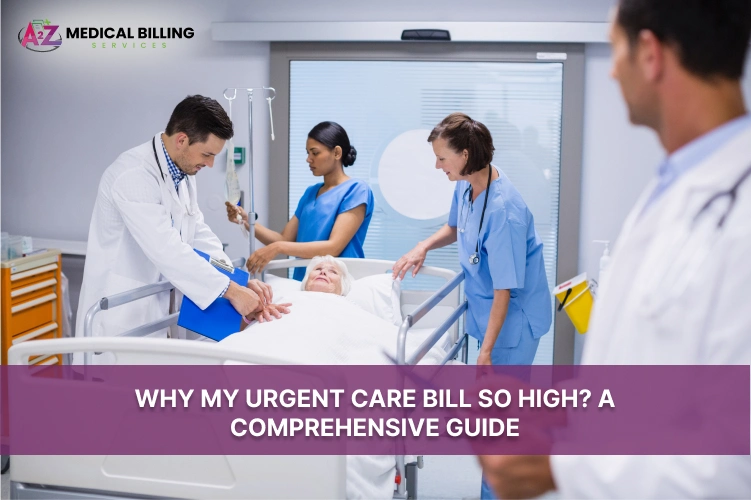Patients frequently ask themselves, Why Is My Urgent Care Bill So High? after understanding the confusing world of medical billing. Many patients who seek care outside of regular doctor’s office hours and anticipate price and convenience can relate to this question. Let’s analyze this worry as medical billing specialists and healthcare workers and offer a clear, in-depth understanding of the costs related to urgent care appointments.
Convenient and Quick Care Has a Price
From the emergency hospital to the regular care physician’s office, urgent care centers provide a speedier and frequently more convenient way to treat non-life-threatening medical conditions. But this convenience has a price tag of its own.
Factors Affecting the Price of Urgent Care
Operational Hours: Generally, urgent care facilities provide services on the weekends, holidays, and beyond regular business hours. The patient bears the increased operational costs resulting from this accessibility.
Resources for Facilities: Urgent care facilities need to stock a variety of medical supplies and equipment to provide a broad range of treatments, from X-rays to stitches, which drives up costs.
Personnel: These facilities staff a group of medical experts who are available to treat patients without appointments to offer emergency care. The price of having competent employees on hand is included in the invoice.
Breakdown of Services and Their Costs
The total cost of care in an urgent care facility includes all services provided, including the initial consultation, diagnostic exams, and treatments. Here’s a simplified version:
Consultation Fee: The standard fee for seeing a medical expert is called the consultation fee.
Diagnostic testing: Because they provide instant answers, services such as lab testing and X-rays are charged separately and frequently at a premium.
Treatment Charges: Additional charges are incurred for specific procedures, such as sutures or injections.
Facility Fees and Specialized Treatment Charges:
The Unknown Contributors of Facility Fees and Specialized Treatment Charges.
The facility fees and charges for specialist treatments are two of the less obvious parts of an urgent care bill:
Facility Fees: This is a charge, similar to what you might see on a hospital bill, for the overhead costs of operating the urgent care center.
Specialized Treatments: The cost of procedures that call for certain tools or knowledge is higher.
A Comparative Perspective
Let’s examine the prices of typical services at urgent care facilities and standard doctor’s offices to get a clearer picture:
Facility Fees and Specialized Treatment Charges:
The Unknown Contributors of Facility Fees and Specialized Treatment Charges.
The facility fees and charges for specialist treatments are two of the less obvious parts of an urgent care bill:
Facility Fees: This is a charge, similar to what you might see on a hospital bill, for the overhead costs of operating the urgent care center.
Specialized Treatments: The cost of procedures that call for certain tools or knowledge is higher.
A Comparative Perspective
Let’s examine the prices of typical services at urgent care facilities and standard doctor’s offices to get a clearer picture:
Facility Fees and Specialized Treatment Charges: The Hidden Contributors
The costs associated with specialist treatments and facility fees are two of the less obvious parts of an urgent care bill:
Facility Fees: These fees cover the operational overhead of the urgent care facility and are comparable to those you might see on a hospital bill.
Specialist Treatments: Procedures that cost more are those that call for specialist tools or knowledge.
An Analytical Perspective
Let’s contrast the prices of typical services at urgent care facilities with those at conventional doctor’s offices to provide a better idea:
To provide a clearer picture, let’s compare the costs of common services at urgent care centers versus traditional doctor’s offices:
| Service | Doctor’s Office Cost | Urgent Care Cost |
| Basic Consultation | $100 – $250 | $150 – $350 |
| X-ray | $60 – $200 | $120 – $300 |
| Blood Test | $25 – $150 | $50 – $250 |
| Stitches | $150 – $350 | $200 – $500 |
Note: These are estimated ranges and can vary based on location and specific urgent care facilities.
Are Urgent Care Visits Covered by Insurance?
Many people seek quick treatment at urgent care centers when they have an unforeseen medical problem. The financial component of these trips might be considerably impacted by the insurance coverage issue, though. Having a clear understanding of how your insurer handles urgent care can help you control costs and expectations.
An Overview of Urgent Care Visit Insurance Coverage
Urgent care appointments are generally covered to some extent by most health insurance policies. Typically, the coverage ranges from common illnesses to minor injuries and encompasses a variety of services provided by urgent care centers. However, depending on your particular insurance policy, the amount of coverage and the out-of-pocket expenses may differ significantly.
Urgent Care Facilities: In-Network vs. Out-of-Network
In-Network: You will often pay less at urgent care facilities that are a part of your insurance network. Lower copays and deductibles for insured individuals result from insurance companies negotiating costs with these providers.
Out-of-Network: You may have to pay more out-of-pocket if you visit an urgent care facility that is not covered by your insurer. You can be responsible for the majority of the costs if your insurance only covers a fraction of the bill or none at all.
| Factor | In-Network | Out-of-Network |
| Cost to Patient | Lower due to negotiated rates | Higher as it’s based on non-negotiated charges |
| Insurance Coverage | Typically extensive, lower copays | May be limited or not covered |
| Out-of-Pocket Costs | Generally lower, due to in-network benefits | Significantly higher, especially for deductibles and copays |
How Insurance Coverage Levels Affect Out-of-Pocket Costs
Your out-of-pocket costs for urgent care visits are mostly determined by the extent of your insurance coverage. Important elements consist of:
Deductibles: The sum that must be paid out of pocket before your insurance starts to pay for expenses. Urgent care visits may have greater initial out-of-pocket costs for those with high deductible plans.
Coinsurance and Copays: A copay is a set sum that is typically paid at the time of treatment for medical services. Coinsurance is a portion of the total cost of medical services that are covered. Both can impact the overall cost of an urgent care visit and differ depending on the plan.
Limits on Coverage: There are restrictions on the number of covered visits or the total amount that must be paid for urgent care under certain insurance policies.
How Much Does MedExpress Cost With Insurance?
One of the best examples of an urgent care facility that many people choose to get emergency medical care is MedExpress. Knowing how much treatments at MedExpress cost, particularly after insurance is applied, can provide important context for discussing the urgent care billing issue as a whole. Let’s examine the elements that go into your ultimate bill when using insurance at places like MedExpress.
Case Study on MedExpress as an Example of an Urgent Care Provider
MedExpress Urgent Care is renowned for delivering a detailed array of medical services, focusing on everything from diagnosing and treating illnesses and injuries to doing lab work and X-rays. Being a walk-in center, it takes great satisfaction in its efficiency and convenience qualities that are highly valued in emergency medical circumstances.
Analysis of Typical Insurance Coverage for Services at MedExpress
MedExpress’s insurance policies differ greatly depending on the insurance company and plan, just like those of other urgent care centers. Although the amount of coverage varies, most insurance plans typically pay for urgent care visits. These are important things to remember:
Co-pays and Deductibles: An urgent care visit may have a co-pay that is greater than that of a typical doctor’s appointment but less than that of an emergency department visit, depending on the specific insurance plan. The amount you must pay in deductibles, or before your insurance begins to pay, has an impact on the final cost.
In-Network vs. Out-of-Network: You’ll probably spend less out of pocket if MedExpress is covered by your insurer. Being outside of the network may result in increased expenses and maybe total bill liability.
Services That Are Covered: Certain services might be better covered than others. The entire cost may vary depending on whether diagnostic tests and treatments get refunded during the visit.
Factors Affecting the Final Cost After Insurance at Urgent Care Facilities Like MedExpress
Your total bill after insurance contributions may vary depending on a number of factors:
Insurance Plan Details: Your out-of-pocket expenses are significantly influenced by the details of your plan, including as deductibles, co-pays, and coinsurance rates.
Kinds of Services Obtained: The type and quantity of services (such as lab tests and medical treatments) you receive during your visit may have an impact on the total cost. Depending on your plan, some services might be covered differently.
Extra Fees: Expenses for certain procedures that aren’t entirely covered by insurance or facility fees may further raise the final bill.
Does My Insurance Cover Urgent Care?
How much, if at all, your insurance covers for your visit is one of the key factors influencing your urgent care price. Knowing what your insurance covers is essential, especially with the growing trend of people turning to urgent care facilities for quick medical attention.
Steps to Determine if Your Insurance Plan Covers Urgent Care Visits
Review Your Insurance Policy: Examine the documentation about your insurance coverage in detail first. To determine the extent of coverage, look for passages that expressly address urgent care services.
Speak with Customer care: Get in touch with your insurance provider’s customer care if the documentation is unclear. They can explain the circumstances around the coverage of urgent care visits.
Look for In-Network Facilities: Usually, networks of preferred providers are maintained by insurers. To guarantee better coverage and fewer out-of-pocket expenses, find out if the urgent care facility you intend to attend is in-network.
Importance of Understanding Your Insurance Policy’s Fine Print
Deductibles and Copays: The Value of Being Aware of the Fine Print, Deductibles, and Copays on Your Insurance Policy Knowing these amounts can have a big impact on how much you have to pay out of pocket. You might have to cover the majority of the cost of an urgent care visit if your insurance has a high deductible.
Details of Service Coverage: Certain kinds of urgent care services may be covered by certain insurers but not by others. Acquiring these particulars can help avoid unforeseen expenses.
Limitations & Exclusions: Understand any policy exclusions or limitations that can impact urgent care service coverage.
Tips for Verifying Urgent Care Coverage Before a Visit
Check the Network Status of the Center: Make sure an urgent care facility is covered by your insurance before visiting it. To obtain the most recent information, visit the website of your insurer or give them a call.
Inquire About Estimated Costs: Do not be afraid to enquire about the projected expenses for the visit and any particular treatments you may require from the urgent care facility. This might assist you in estimating possible out-of-pocket costs.
Pre-Authorization May Be Required: For certain services to be reimbursed by some insurance plans, pre-authorization may be necessary. Verify if this is covered by your plan, and if not, get it.
Do You Pay Upfront at Urgent Care?
One of the most important aspects of minimizing healthcare costs involves understanding the urgent care center payment procedure. Whether patients must pay in full for treatments received at urgent care centers is a frequent query. It might be beneficial to manage expectations and costs by being aware of these billing methods and how they connect to insurance deductibles and copays. What you should know is as follows.
Typical Billing Procedures for Upfront Payments at Urgent Care Facilities
Patients in urgent care facilities frequently have to pay in advance for services, which usually include:
Copays: A predetermined sum that is determined by your insurance plan and that you must pay at the time of service.
Deductibles: You might be required to pay a portion of the service charge up front if there is a deductible associated with your insurance plan that hasn’t been satisfied.
Uninsured or Self-Pay: Patients may be expected to pay the entire estimated cost of
the appointment upfront if they do not have insurance or if they prefer not to use it.
How Upfront Payments Relate to Insurance Deductibles and Copays
Allowable deductions: The amount you have to pay out-of-pocket before your insurance begins to cover expenses is known as your deductible, and it may include the upfront payment.
Copays: The amount you pay at the time of your visit for healthcare services is predefined and can be thought of as part of the upfront payment.
Insurance Plan Verification: To determine how much you might have to pay up front depending on your deductible and copay requirements, it’s critical to confirm the specifics of your insurance plan in advance.
Techniques for Handling Billing Conflicts and Upfront Payments
Following Techniques must be helpful:
Check Your Coverage Before Your Visit: Get in touch with your insurance provider to find out the specifics of your plan, including copays and deductibles, so you are prepared.
Request an Approximation: Ask the urgent care facility in advance for an estimate of the visit’s cost and any services that may be anticipated.
Examine Your statement: Following your appointment, go over your comprehensive statement to make sure all of the costs are reasonable and appropriate for the services you received.
Negotiate Payment Plans: Find out whether the urgent care facility offers payment plans if you’re having trouble paying the large upfront charges.
FAQs:
Q1: Why is my copay so expensive?
Copays are set by your insurance plan, reflecting the type of healthcare service you’re receiving. Urgent care copays are often higher than those for regular doctor visits due to the convenience and broader range of services provided on a walk-in basis, representing a middle ground between primary care and emergency room costs.
Q2: Why do so many people go to urgent care?
Urgent care centers have grown in popularity primarily due to their convenience and accessibility. They offer a quick solution for non-life-threatening medical issues without the long waits associated with emergency rooms or the need for an appointment like most primary care physicians require, making them a go-to for immediate healthcare needs.
Q3: What are the best times to go to urgent care?
To minimize wait times and potential costs at urgent care, consider visiting during weekday mornings or mid-afternoons when centers are less busy. Avoid evenings and weekends if possible, as these are peak times due to people being off work or school, which can lead to longer waits and potentially higher demand for services.
Let’s Recap
We have examined every aspect of urgent care billing in this comprehensive guide, helping to clarify why invoices may appear greater than anticipated. We’ve addressed the essential factors that influence your final bill, from understanding the subtleties of insurance coverage such as copays and deductibles to recognizing the operational dynamics that drive up expenses at urgent care facilities. We have also provided information on the accessibility and convenience of urgent care, which, while advantageous, has its own set of budgetary issues.



